Are you a Quiet Speculation member?
If not, now is a perfect time to join up! Our powerful tools, breaking-news analysis, and exclusive Discord channel will make sure you stay up to date and ahead of the curve.
Welcome to the start of Modern Horisons 2 spoiler season. The official start, anyway. The teasers we’ve already received don’t count. Because those were preseason teasers, not spoilers. There must be a difference other than semantics. I have no idea what beyond the timing is actually different, but there must be one to justify calling Monday the official start of MH2 spoilers. Rather than what we got two weeks ago. Or last Thursday. I’m starting to think Wizards just wants Magic news to be one, continuous spoiler season. Which would help explain this year’s release schedule, now that I’ve said it out loud.
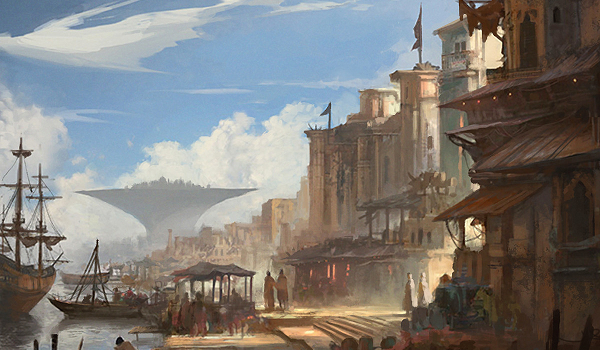
In any case, Wizards does appear to be taking a more measured approach to MH2 compared to Modern Horizons. MH1 had a lot to prove as the first direct-to-and-designed-for-Modern set in Magic’s history. This may be why Wizards looked to push the flashier cards and more powerful cards on us. Which went well. Having learned their lesson (and with less player-skepticism to overcome) Wizards looks to have scaled things back and is focusing on answer cards. So far. But MH2’s Hogaak, Arisen Necropolis may be waiting until the last minute to appear, for all we know.
Rishadan Dockhand
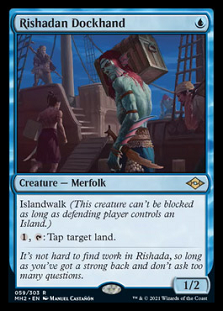 Of course I was going to start with the Merfolk. The most important Merfolk printed since Master of the Pearl Trident, no less. I’m neither joking nor exaggerating. Rishadan Dockhand, a 1/2 for one with islandwalk, is better than any other one-drop Merfolk printed since Cursecatcher. I thought that might be the case when Kumena's Speaker was spoiled, but that proved incorrect. It happened again with Benthic Biomancer. The problem is not that Merfolk lacks one-drop beaters. It had all the lordly beef and mana-curve power to be an aggro deck. And that wasn't enough to keep up in Modern.
Of course I was going to start with the Merfolk. The most important Merfolk printed since Master of the Pearl Trident, no less. I’m neither joking nor exaggerating. Rishadan Dockhand, a 1/2 for one with islandwalk, is better than any other one-drop Merfolk printed since Cursecatcher. I thought that might be the case when Kumena's Speaker was spoiled, but that proved incorrect. It happened again with Benthic Biomancer. The problem is not that Merfolk lacks one-drop beaters. It had all the lordly beef and mana-curve power to be an aggro deck. And that wasn't enough to keep up in Modern.
What was missing was something disruptive to upgrade or compliment Cursecatcher. Because just look at the gap between Cursecatcher and Mausoleum Wanderer. The key to aggro in Modern is to either be blisteringly fast (à la Prowess), include a combo kill (Affinity, Company decks), or be highly disruptive (Spirits, Death and Taxes). Back when I was on the 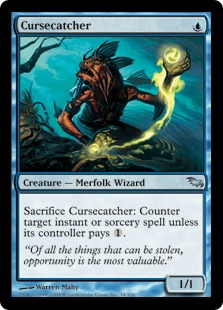 all-Merfolk, all-the-time plan, Cursecatcher was a solid creature and piece of disruption. Over the years, the creatures got better and the spells got cheaper and suddenly Cursecatcher just didn't do much anymore. To have a chance, Merfolk needed something interactive at one mana, not more beef. The lords had that locked down.
all-Merfolk, all-the-time plan, Cursecatcher was a solid creature and piece of disruption. Over the years, the creatures got better and the spells got cheaper and suddenly Cursecatcher just didn't do much anymore. To have a chance, Merfolk needed something interactive at one mana, not more beef. The lords had that locked down.
That has finally arrived in the form of Rishadan Port on legs fins. Wizards is continuing their practice of bringing Legacy cards to Modern as creatures instead of spells. And I am perfectly fine with that. Speaking as a player of Legacy Death and Taxes, Port is not for Modern. More on that shortly. Being a 1/2 looks weird and isn't particularly aggressive, but is perfect for a metagame defined by Lava Dart and sideboard Plague Engineers. Having islandwalk reduces the need for the lords to chip in the last few points of damage. I'm very excited to get back to my Aether Vial roots with Dockhand.
The Importance of Port
Those who've never played with the card may wonder why Rishadan Port is a big deal. Patrick Sullivan explained it best when he said that Port's power lies not in the fact that it trades 2 of your mana for 1 of your opponent's mana (a bad rate), but that it gives players the ability to do so at any time on a land that otherwise taps for colorless (a fantastic option to have throughout the game), giving this deceptively powerful effect a very low opportunity cost.
The entirety of my experience with Port is in Legacy, and it is extremely powerful as part of DnT's prison plan. Some of this is having Wasteland too, but Legacy is generally so land-light that Port is frequently devastating. So long as you're not behind on board. Then Porting lands just makes you lose more slowly. At best.
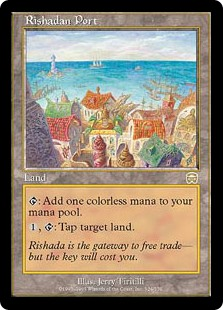 That out of the way, how does being on a creature affect Port's power and playability? On the one hand, the ability to keep opponents off mana is powerful in Modern too. By which I mean Porting Tron. Porting Tron lands is awesome, and will feel far better than Porting Cloudpost in Legacy because it will happen more often. Dockhand isn't a land, so it doesn't tie down your own mana as much as Port. Thus, Dockhand won't harm your own board development as much as Port. However, this comes at the price of being a creature and therefore far more vulnerable than a land. Relying on Dockhand to save you is asking for heartbreak.
That out of the way, how does being on a creature affect Port's power and playability? On the one hand, the ability to keep opponents off mana is powerful in Modern too. By which I mean Porting Tron. Porting Tron lands is awesome, and will feel far better than Porting Cloudpost in Legacy because it will happen more often. Dockhand isn't a land, so it doesn't tie down your own mana as much as Port. Thus, Dockhand won't harm your own board development as much as Port. However, this comes at the price of being a creature and therefore far more vulnerable than a land. Relying on Dockhand to save you is asking for heartbreak.
Merfolk will be playing a full set of Dockhand because it is a Merfolk first and foremost. After that, there's the question of whether to just Port the opponent's lands or attack. I suspect the decision to be largely contextual, shifting turn-by-turn depending on matchup and game state, and made much easier by having Aether Vial in play. However, outside Merfolk, the appeal will be the Port effect, and I expect UW DnT to see a lot of play once MH2 is released. And yes, I'm already testing that deck... stay tuned!
Good Grief
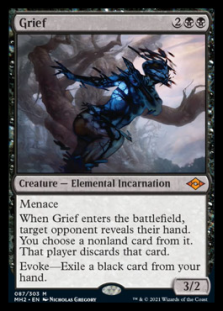 Next up is something I never expected to see in Modern: manaless discard. Grief is a more powerful but less flexible Entomber Exarch if actually paid for. However, its evoke cost turns Grief into Unmask. Or as Unmask was intended to be used, anyway. These days, Unmask is mainly used by Reanimator and Dredge as an emergency discard outlet, with going after the opponent's hand frequently a secondary use. I've lost to a lot of opponents mulliganing to five, then turn 1 Unmasking themselves discarding Avacyn and Griselbrand only to immediately ReanimateAvacyn and Griselbrand. That can't happen with Grief, even in Legacy. As a compensating bonus, Grief can't be Force of Negationed and could also come with a menacing body.
Next up is something I never expected to see in Modern: manaless discard. Grief is a more powerful but less flexible Entomber Exarch if actually paid for. However, its evoke cost turns Grief into Unmask. Or as Unmask was intended to be used, anyway. These days, Unmask is mainly used by Reanimator and Dredge as an emergency discard outlet, with going after the opponent's hand frequently a secondary use. I've lost to a lot of opponents mulliganing to five, then turn 1 Unmasking themselves discarding Avacyn and Griselbrand only to immediately ReanimateAvacyn and Griselbrand. That can't happen with Grief, even in Legacy. As a compensating bonus, Grief can't be Force of Negationed and could also come with a menacing body.
Unmasking a Problem
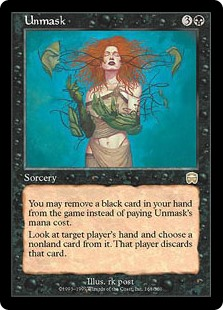 Grief can only ever be used to disrupt opponents, not to advance one's own unfair gameplan. But critically, evoking Grief creates card disadvantage. Thoughtseize is a 1-1 trade whose value comes from trading up on card quality and mana value. An evoked Grief is -1 card (the exiled black card), then the discard is a 1-1 trade. It's harder to say if a 4-mana 3/2 menace is better than the discarded card. Free is much better than costing something, but that only actually matters if you then do something with the mana that's saved. And given the density of black spells that will be necessary to make Grief reliably free (using Force of Will math), the likely other turn-one play is a cantrip or a discard spell, which again just leaves the caster even on cards. By any measure, evoking Grief leaves its caster lower on resources than the target.
Grief can only ever be used to disrupt opponents, not to advance one's own unfair gameplan. But critically, evoking Grief creates card disadvantage. Thoughtseize is a 1-1 trade whose value comes from trading up on card quality and mana value. An evoked Grief is -1 card (the exiled black card), then the discard is a 1-1 trade. It's harder to say if a 4-mana 3/2 menace is better than the discarded card. Free is much better than costing something, but that only actually matters if you then do something with the mana that's saved. And given the density of black spells that will be necessary to make Grief reliably free (using Force of Will math), the likely other turn-one play is a cantrip or a discard spell, which again just leaves the caster even on cards. By any measure, evoking Grief leaves its caster lower on resources than the target.
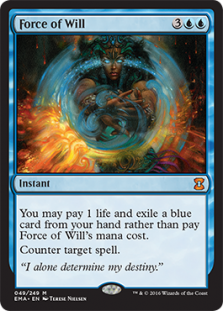 Which is why Unmask never saw much play. The reason that Reanimator and Dredge are the only decks that consistently play Unmask in Legacy is that they don't care about throwing away cards. All that matters is setting up their broken thing, and if that happens, they should win. Thus, it's worthwhile to 2-for-1 themselves to ensure their opponent can't disrupt them or to get the needed card into the graveyard. Fair decks have never made use of Unmask because they have to care about resources. Records are thin because Unmask is from before the internet was widespread, but I could only find three examples of Unmask in Standard or Extended. All three were running additional sources of card advantage to make up for Unmask's disadvantage. Two of them were looking to Dark Ritual huge threats into play on turn one and needed to guard against Force of Will.
Which is why Unmask never saw much play. The reason that Reanimator and Dredge are the only decks that consistently play Unmask in Legacy is that they don't care about throwing away cards. All that matters is setting up their broken thing, and if that happens, they should win. Thus, it's worthwhile to 2-for-1 themselves to ensure their opponent can't disrupt them or to get the needed card into the graveyard. Fair decks have never made use of Unmask because they have to care about resources. Records are thin because Unmask is from before the internet was widespread, but I could only find three examples of Unmask in Standard or Extended. All three were running additional sources of card advantage to make up for Unmask's disadvantage. Two of them were looking to Dark Ritual huge threats into play on turn one and needed to guard against Force of Will.
Squeezing Out Value
Since Modern doesn't have really broken things for black decks to do through Force right now, I'm pretty skeptical of the value of evoking Grief, and subsequently its playability. However, that won't stop players from trying. I've already seen players losing their minds at the thought of responding to the evoke trigger with Undying Evil or Ephemerate. And it's true that successfully combining those cards with Grief makes up for the card disadvantage, since Grief would then remain on the battlefield, not to mention rip another card. And it's not hard to imagine that working out favorably.
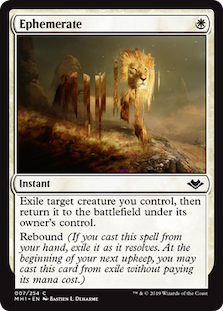 Still, that strikes me as the best-case scenario, and constructing a deck to do so consistently makes me question how well it functions outside of that specific play pattern. The accepted hypergeometric probability to have a given card in the opening hand is just under 40%. The probability of having Grief and another specific card is 16%-42% depending on how you perform the calculation. And that's not including the need to find another black card. In other words, trying to make evoking Grief work in a deck that cares about resource economy is going to be a lot of work. Work that could have gone into building a more reliable engine.
Still, that strikes me as the best-case scenario, and constructing a deck to do so consistently makes me question how well it functions outside of that specific play pattern. The accepted hypergeometric probability to have a given card in the opening hand is just under 40%. The probability of having Grief and another specific card is 16%-42% depending on how you perform the calculation. And that's not including the need to find another black card. In other words, trying to make evoking Grief work in a deck that cares about resource economy is going to be a lot of work. Work that could have gone into building a more reliable engine.
Casting Grief is fine, but 3/2s for four mana don't see play even if they have evasion. By then, it's often too late in the Modern game for the discard to be relevant in anything other than control matchups (Thought-Knot Seer is so good because it generally costs a functional three mana). Tribal Elementals may use Grief in that capacity, especially since it does play acceleration and Cavern of Souls. I'd be very surprised to see Grief anywhere else.
A Wonderous Reprint
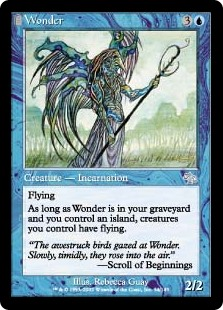 Immediately after Grief was spoiled, there was speculation that it was part of a cycle because it was an incarnation. That's a rare creature type and always shows up in cycles. Are we to see more evoke creatures? That is still possible, but the spoiling of Bazaar of Wonders has dampened those hopes. Not that I'm complaining; it's great to see an old friend again. I have very fond memories of winning my first FNM with UG Madness thanks to Bazaar of Wonders jumping my alpha strikes over Phantom Centaur and Nantuko Shade. However, I don't think there will be any of that today. There are no fair blue decks with discard synergies which would use Bazaar of Wonders for its intended purpose. Grixis Death's Shadow is the closest, but I don't think it needs Bazaar of Wonders nor can spare the space. Also, graveyard hate wasn't a thing back then.
Immediately after Grief was spoiled, there was speculation that it was part of a cycle because it was an incarnation. That's a rare creature type and always shows up in cycles. Are we to see more evoke creatures? That is still possible, but the spoiling of Bazaar of Wonders has dampened those hopes. Not that I'm complaining; it's great to see an old friend again. I have very fond memories of winning my first FNM with UG Madness thanks to Bazaar of Wonders jumping my alpha strikes over Phantom Centaur and Nantuko Shade. However, I don't think there will be any of that today. There are no fair blue decks with discard synergies which would use Bazaar of Wonders for its intended purpose. Grixis Death's Shadow is the closest, but I don't think it needs Bazaar of Wonders nor can spare the space. Also, graveyard hate wasn't a thing back then.
Dredge is another candidate, but it doesn't normally run any Islands and I can't imagine that it wants to change up its manabase. Especially when it doesn't worry too much about being blocked in the first place. And also has Conflagrate to clear blockers out or win the game. Millvine on the other hand does already run Islands, dump its library, look to win via quick alpha strike. Bazaar of Wonders is a more natural fit there. It just makes me sad to see my old friend working for the enemy.
Fast Facts
There are a number of other interesting reprints too. However, there's not enough to say about them to warrant whole sections. So I'm going to wrap things up today with some quick-fire card reviews.
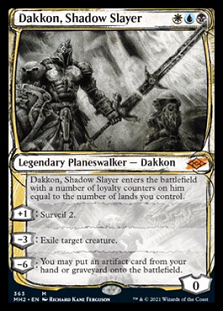 Cabal Coffers: Another Odyssey block reprint. It's much better now that Urborg, Tomb of Yawgmoth and Dryad of the Ilysian Grove exist and let Coffers see play outside of mono-black decks. It's much, much worse because the opportunity cost of playing lands that don't make mana themselves is so high in Modern.
Cabal Coffers: Another Odyssey block reprint. It's much better now that Urborg, Tomb of Yawgmoth and Dryad of the Ilysian Grove exist and let Coffers see play outside of mono-black decks. It's much, much worse because the opportunity cost of playing lands that don't make mana themselves is so high in Modern.
Dakkon, Shadow Slayer: Dakkon is proof that Wizards actually can balance three mana planeswalkers. With turn-two ramp, Dakkon can ultimate is turn 5. Otherwise, it's turn 6 at earliest. And that ultimate is only good if it's been set up first. Thus, he's much better the later he's played, and so not really a turn-three play. Which leads 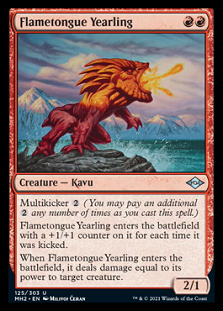 me to ask why you need to use Dakkon to cheat in the artifact rather than just cast it? Or Refurbish it several turns earlier? Surveiling every turn is decent, especially as a way to set up graveyard synergies, and exiling creatures is very good. But is either enough for Dakkon to see play?
me to ask why you need to use Dakkon to cheat in the artifact rather than just cast it? Or Refurbish it several turns earlier? Surveiling every turn is decent, especially as a way to set up graveyard synergies, and exiling creatures is very good. But is either enough for Dakkon to see play?
Flametongue Yearling: I don't know if Flametongue Kavu would see play in Modern today, but I'm betting Yearling won't. It's worse than Kavu at the same mana value, and decks that would potentially play Yearling don't need mana sinks. Especially ones that just kill creatures, and at a mediocre rate for anything  above three toughness. Also important to note, Yearling kills itself if played on an empty board. A chip off the old block.
above three toughness. Also important to note, Yearling kills itself if played on an empty board. A chip off the old block.
Prismatic Ending: This card will see a lot of play in UWx control because it kills Prowess creatures and Wrenn and Six on curve. I don't know if any deck other than control wants a sorcery-speed exile spell. Also, it has a hard ceiling of mana value 5, so it's not quite as unequivocal as Detention Sphere.
Back Into the Horizon
We've only had a bare glimpse of what MH2 has to offer, and while the early indications are good, don't let your guard down. I underestimated Astrolabe last time. But, that will have to wait. Next week is the May metagame update. See you then!



